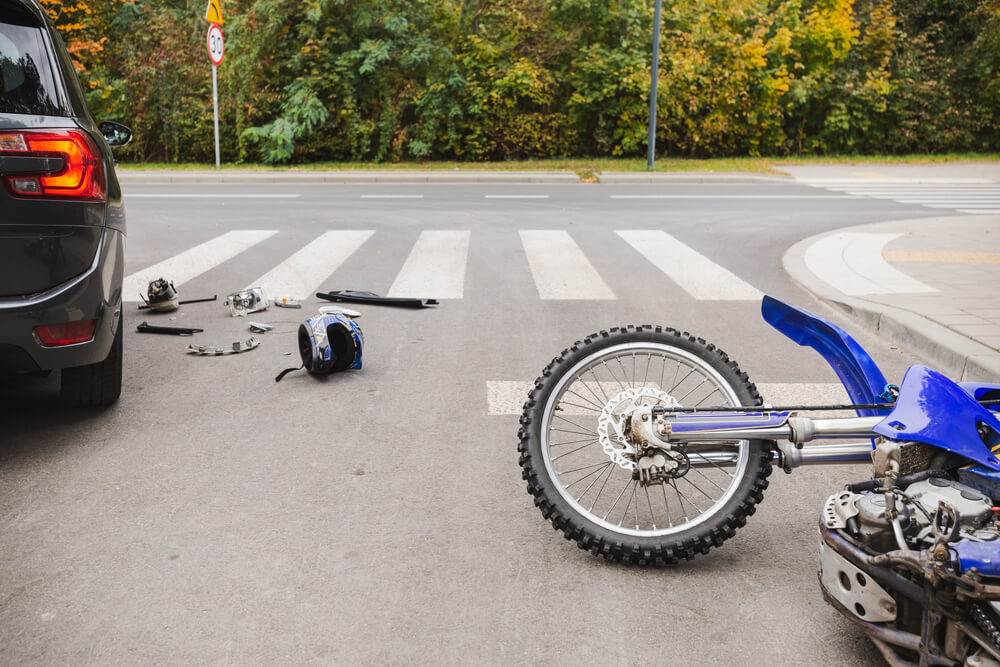California’s motorcycling community is vast and diverse, benefiting from some of the most scenic roads in the country. However, riding a motorcycle comes with responsibilities. Motorcyclists must follow motorcycle laws in California to avoid penalties and help keep the roads safe for everyone.
The Importance of Following Motorcycle Laws in California

Motorcycles come with risks and account for a significant percentage of traffic fatalities. Since motorcyclists are more vulnerable to dangers on the road, they must take proper safety precautions to protect themselves and others. By following California motorcycle laws, motorcyclists can reduce their risk of getting into an accident.
Motorcycle Fatalities in California: Statistics and Trends
Motorcyclists represent over 13% of casualties on the road in California, despite the fact that motorcycles make up only 3.5% of registered vehicles in the United States.
Motorcycle operators who speed, consume alcohol or other drugs while driving or fail to wear helmets are more likely to end up in a fatal crash. Motorcycle operators who wear helmets and other protective gear, ride defensively and follow lane-splitting laws can decrease their chances of getting into a fatal crash.
Learning the Rules for Riding a Motorcycle in California
The California Department of Motor Vehicles (DMV) has a guide and a handbook for California motorcyclists. These extensive resources cover the laws that motorcycle operators must follow in the state of California. These resources also discuss recommended safety practices. California motorcycle laws cover many aspects of operating a motorcycle–from registration to driving in traffic.
Safety Gear Beyond Helmets

Helmets are not the only protective gear motorcyclists should consider. Motorcyclists in California should wear other protective articles of clothing in addition to helmets. This additional gear includes:
-
Protective Jackets and Pants: Jackets and pants made from leather or other durable materials can provide a layer of protection in the event of a fall or crash. They can help prevent road rash and reduce the risk of severe injuries.
-
Gloves and Boots: Sturdy gloves and boots offer added protection for your hands and feet. Gloves can improve your grip on the handlebars, while boots protect your feet and ankles from potential injury.
-
Eye Protection: If your helmet does not have a visor, you should wear goggles or glasses to protect your eyes from debris, wind and insects.
Though California does not require motorcycle riders to wear these items, these items can help minimize injuries in the event of an accident. They are therefore highly encouraged for any motorcyclist looking to maximize their protection on the road.
Rules Regarding Passengers
California has laws regarding motorcycle passengers as well as drivers. Just like motorcycle drivers, passengers must also wear helmets that meet federal safety standards. Additionally, motorcycles must have passenger footrests, and passengers must sit on a securely attached seat that’s designed to carry more than one person.
Do Motorcycles Have the Right of Way in California?
Motorcycles in California do not enjoy special privileges or a unique right of way. Like any other vehicle, motorcyclists must obey traffic laws, yield when necessary and follow the rules of the road.
Intersection Protocols for Motorcycles
Motorcyclists should exercise caution at intersections, ensuring that they are visible to other drivers. The law requires motorcyclists to yield the right of way in the same situations that apply to other drivers. This includes yielding to pedestrians, stopping at stop signs and red lights and obeying traffic signals.
Lane Positioning and Visibility

Motorcyclists have the right to use the full width of a lane, just like any other vehicle. However, many motorcyclists choose to ride closer to the center or side of the lane to avoid obstacles or to increase visibility. When riding in traffic, motorcyclists should avoid driving in drivers’ blind spots and make an effort to be visible to other motorists.
Motorcyclists can improve their visibility by wearing bright or reflective clothing, using their headlights and positioning themselves in a way that makes them more noticeable to other drivers. Additionally, motorcyclists can use hand signals along with turn signals to help ensure other drivers are aware of their intentions.
Is It Legal to Split Lanes on a Motorcycle in California?
California allows motorcyclists to split lanes. The California state government officially made lane splitting legal for motorcyclists in 2016 with the passage of Assembly Bill 51.
To reduce the risk of an accident, motorcyclists should only split lanes when traffic is moving at 30 miles per hour or less, and they should not exceed the speed of surrounding traffic by more than 10 miles per hour.
Lane Splitting Best Practices
To lane split safely, motorcyclists must be constantly aware of their surroundings. When lane splitting, riders should be aware of the movement of other vehicles and anticipate possible lane changes. They should also be extra cautious when lane splitting near large trucks or buses, as these vehicles have larger blind spots. When possible, they should avoid splitting lanes between two large vehicles, as the space may be too tight.
Public Perception of Lane Splitting
While lane splitting is legal, it remains a controversial practice. Some drivers believe it’s unsafe and assert that motorcyclists who split lanes are reckless.
Supporters of lane splitting argue that it helps reduce traffic congestion and allows motorcyclists to avoid the dangers of stop-and-go traffic.
Motorcyclists should be aware of this public perception and exercise caution when lane splitting. Being courteous to other drivers, using hand signals and following the recommended safety guidelines can help improve the relationship between motorcyclists and other drivers on the road.
Can You Ride a Motorcycle in California Without a Motorcycle License?
You cannot legally ride a motorcycle in California without a valid motorcycle license or endorsement. Riding without a license not only exposes you to legal penalties but can also increase your liability in the event of an accident.
Motorcycle Endorsement (M1 License)
To legally operate a motorcycle in California, you must obtain a motorcycle endorsement, often referred to as an M1 license. This endorsement is an addition to your regular driver’s license and allows you to operate any two-wheel motorcycle, motor-driven cycle, motorized scooter, and all vehicles listed under Class M2.
To qualify for an M1 endorsement, applicants must be at least 16 years old. Riders under 21 must complete a mandatory motorcycle safety training course, while riders over 21 have the option to take the course or opt for the DMV skills test. Additionally, all applicants must pass a written knowledge test that covers motorcycle-specific laws and safety practices.
Penalties for Riding Without a License
Riding a motorcycle without a license can result in fines, points on your driving record and even the impounding of your motorcycle. Furthermore, if you do get in an accident while riding without a license, you may face increased legal and financial liability. Without proper licensing, it can be challenging to file an insurance claim, and you may be partially or fully liable for the damages and injuries caused in the accident.
Motorcycle Insurance Requirements in California
California law requires all motor vehicles, including motorcycles, to have insurance. Motorcyclists must carry liability insurance that meets the state’s minimum requirements. This insurance covers the costs associated with accidents, including property damage and injuries sustained by other parties.
Minimum Insurance Coverage
The minimum liability insurance coverage required for motorcycles in California includes:
-
$15,000 for injury or death per person
-
$30,000 for injury or death per accident
-
$5,000 for property damage
While these are the minimum requirements, motorcyclists may want to consider purchasing additional coverage to protect themselves in the event of an accident. Comprehensive and collision coverage can help cover the costs of repairing or replacing your motorcycle, while uninsured/underinsured motorist coverage can protect you if you get in an accident with a driver who does not have sufficient insurance.
What Happens After a Motorcycle Accident in California?

To protect yourself and others, it’s important to take the right steps after involvement in a motorcycle accident.
One of the first things you should do after a crash involving a motorcycle is seek medical attention. Even if you feel fine after the accident, remember that some injuries may not be immediately apparent. A medical evaluation will also create a record of your injuries, which can help you if you pursue a claim or lawsuit.
You should also report the accident. California law requires you to report any accident that results in injury, death or property damage in excess of $1,000 to law enforcement. Failure to do so can result in penalties and may complicate any insurance claims you need to file.
If you are physically able, gather as much information as possible at the scene of the accident. This includes taking photos of the damage to your motorcycle, the other vehicle(s) involved and any visible injuries. You should also collect contact information from the other driver(s) and witnesses.
Notify your insurance company about the accident as soon as possible. Be honest and thorough in your report, but avoid admitting fault or speculating about the cause of the accident.
Furthermore, you should speak with an attorney. Consulting with a personal injury attorney in Phoenix can help protect your rights and ensure that you receive fair compensation for your injuries and damages.
Common Causes of Motorcycle Accidents in California
Motorcycle accidents can happen for a variety of reasons, some of which are beyond the rider’s control. Common causes of motorcycle accidents include distracted driving, left-turn accidents, speeding and lane-splitting accidents.
Distracted Driving
Distracted driving is a leading cause of motorcycle accidents. Motorists who are texting, eating or engaging in other activities while driving may fail to notice motorcyclists on the road. Because motorcycles are smaller and more difficult to see than other vehicles, distracted drivers are more likely to collide with them.
Left-Turn Accidents
Left-turn accidents are another common cause of motorcycle crashes. These accidents often occur when a car is making a left turn at an intersection and fails to see an oncoming motorcycle.
Speeding
Speeding is a factor in many motorcycle accidents, both for motorcyclists and other drivers. Motorcycles are capable of reaching high speeds quickly, and speeding increases the likelihood of losing control or being unable to react in time to avoid a collision. Drivers who are speeding may also have difficulty seeing motorcycles or accurately judging their speed.
Lane Splitting Accidents
Lane splitting, while legal in California, can still lead to accidents, particularly if one does it in an unsafe manner. Motorcyclists who lane split at high speeds or weave in and out of traffic are at a higher risk of colliding with other vehicles. Additionally, drivers who are not accustomed to lane splitting may change lanes without checking for motorcycles, leading to serious accidents.
What Are the Penalties for Motorcycle Violations in California?

The penalties faced by motorcyclists for not following California’s motorcycle laws vary depending on the severity of the situation. Penalties include fines, license suspensions and motorcycle impoundment.
Traffic Violations and Fines
Motorcyclists in California are subject to the same traffic laws and fines as other drivers. Common traffic violations, such as speeding, running a red light or failing to signal, can result in fines, points on your driving record and increased insurance premiums. Accumulating too many points on your driving record can lead to the suspension of your license.
Riding Without a Helmet
Riding without a helmet is a violation of California’s helmet law and can result in fines of up to $250 and/or one year of probation.
The Role of Personal Injury Attorneys in Motorcycle Accident Cases
Motorcycle accident victims generally need to file claims with insurance companies and negotiate to receive compensation for their damages. If negotiations fail, they may need to bring their case to court.
Motorcycle accident victims who pursue compensation without the support of a lawyer may receive unfair settlements. It’s therefore important to work with an experienced personal injury lawyer. Personal injury attorneys can help prove fault, calculate damages, negotiate with insurance companies and perform many other tasks to help victims reach the best possible outcome.
Proving Fault in a Motorcycle Accident
One of the most important aspects of a motorcycle accident case is proving fault. California follows a comparative negligence rule, which means that fault is potentially shared between multiple parties. In some cases, courts may find both the motorcyclist and the other driver partially responsible for the accident.
Personal injury attorneys can help gather evidence, such as police reports, witness statements and accident reconstruction data, to establish fault and build a strong case on behalf of the injured motorcyclist.
Calculating Damages
Motorcycle accidents can result in severe injuries and other damages. These injuries may require long-term medical treatment and rehabilitation. They may also lead to a loss of income. Personal injury attorneys can calculate the full extent of these damages so that the victim can pursue fair compensation.
Negotiating with Insurance Companies
Insurance companies often attempt to settle accident claims for as little as possible. Personal injury attorneys have experience negotiating with insurance companies and can help ensure that accident victims receive a fair settlement. If the insurance company refuses to offer a reasonable settlement, the attorney can bring the case to court to pursue full compensation.
Motorcycle Laws in California Can Work in Your Favor
At Sargon Law Group, we understand the motorcycle laws in California and have a history of helping accident victims receive the compensation they deserve after suffering personal injuries or other damages. If you’ve been in an accident, contact us for a free consultation with our Phoenix motorcycle accident lawyers. We’re here to protect your rights and help you reach a favorable settlement.
